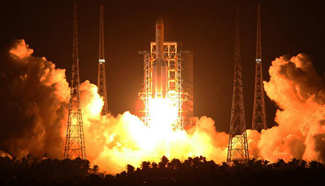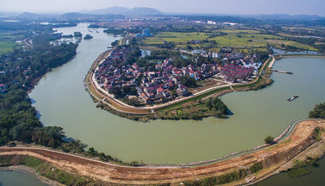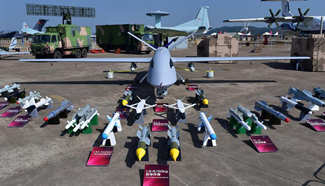WASHINGTON, Nov. 3 (Xinhua) -- China's launch of its first heavy-lift rocket, the Long March-5, on Thursday reflects the country's "greatest advancement" in developing a new launcher family for both its un-crewed and crewed space programs, a U.S. space expert told Xinhua.
The rocket launched from the coastal Wenchang Space Launch Center in southern Hainan Province matches the performance of a medium U.S. heavy-lift launch vehicle such as the Delta-4 Heavy, capable of delivering a payload of 25 tons to low Earth orbit, said Charles Vick, senior technical & space policy analyst with U.S. think tank globalsecurity.org.
Vick believed the Long March-5 will be used in China's missions to build its Earth-orbiting space station and will also allow the country to conduct lunar and planetary un-crewed explorations expected to follow in the next five years or so.
"Eventually once the Long March-5 has gained high reliability, it will serve several mission for the crewed lunar program efforts and may become the crew launch vehicle for the eventual crewed lunar landing programs in planning," he said. "Additionally the Long March-5 is planned for the use of China's national and commercial COMSAT programs."
The Long March-5 is part of a new generation of China launch vehicles that aims to replace the older series of the Long March family, known as Long March 2, 3 and 4.
Instead of highly toxic propellants, the new series, also consisting of Long March 6 and 7, uses kerosene and liquid oxygen, making it more environmental friendly and less expensive.
Vick said he was also impressed that this new Long March series was developed without the Russian rocket engine technology know-how and the U.S. cryogenic technology involved.
Currently, the U.S. has several heavy-lift launch vehicles that are utilized for several payload capacity categories, including Atlas-5 and Delta-4.
Meanwhile, there are four others in development: Vulcan, Falcon Heavy and New Glenn from the U.S. commercial space sector as well as the U.S. space agency NASA's Space Launch System.
Vick said many factors are driving the space access launch vehicle industries in the U.S. and China, but each nation has its own goals.
"I would not call this a space race except for the best technological option for space access to serve each country's purposes," he said.










